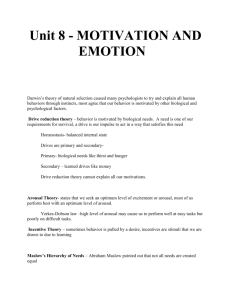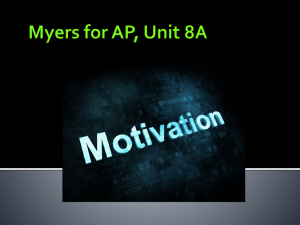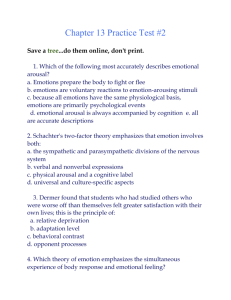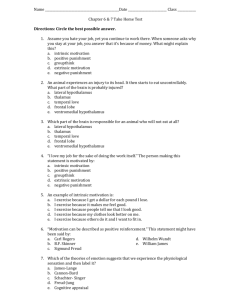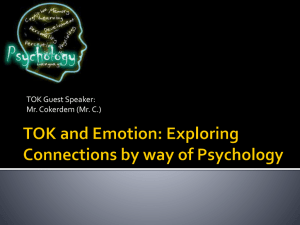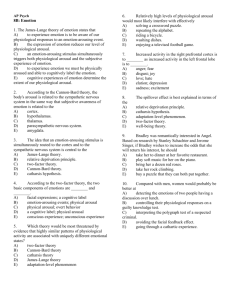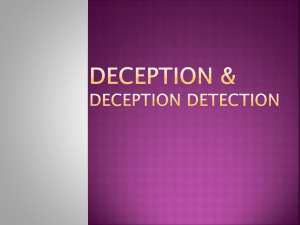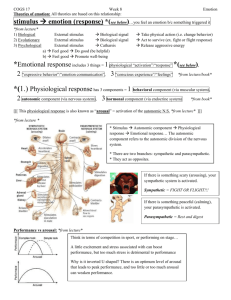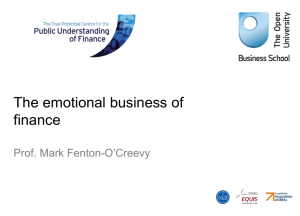Chapter 9 Powerpoint
advertisement
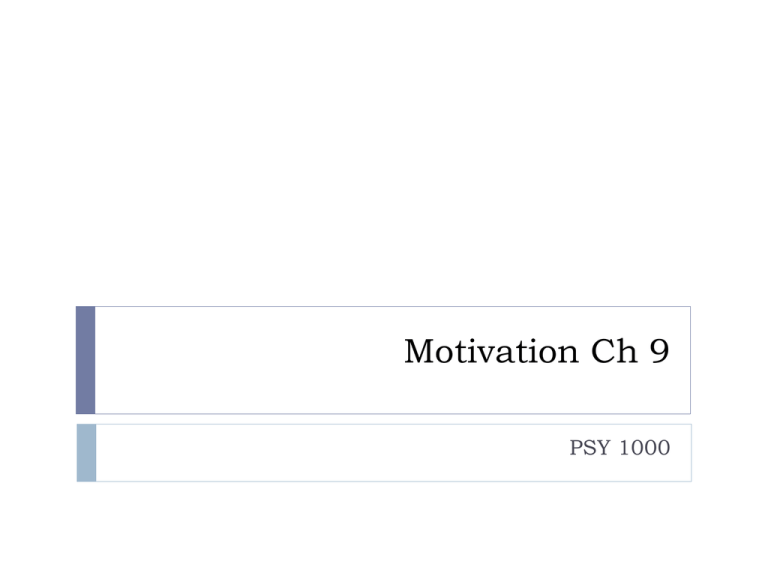
Motivation Ch 9 PSY 1000 Motivation Process by which activities are started, directed, and continued Meets our physical and psychological needs or wants Types of Motivation Extrinsic Motivation Perform and action that leads to an outcome outside of self Work for money Decreases creativity Intrinsic Motivation Perform an action because the act itself is rewarding or satisfying Good grades to feel proud Physical challenges Becomes ours Approaches to Motivation Instinct Biologically determined and innate patterns of behavior William McDougall proposed 18 instincts for humans Frued Psychoanalytical Theory Flight, running away Aggressiveness Gathering possessions Concepts of instincts reside in the id, basic human needs and drives This theory has faded since it is able to describe the behavior but not explain it Approaches to Motivation Drive Reduction Behavior arises from physiological needs that cause internal drive to satisfy need and reduce tension Primary Drive Acquired (secondary) Drive Learned through experience or conditioning Money Social approval Homeostasis Survival needs of the body such as hunger, thirst Body is in a state of imbalance Body maintains a steady state Does not explain all human behavior Approaches to Motivation Arousal The need for stimulation Curiosity, playing, exploration People have an optimal level of tension Some tasks may have a high level of arousal Anxiety over a test Nervous over a first date Maintaining an optimal level may require increasing or decreasing tension Sensation Seekers Need more complex and varied sensory experiences than do others Approaches to Motivation Incentive Things that attract or lure people into action External stimulus and its rewarding properties No need No tension Expectancy-value Theories Actions of humans cannot be fully understood without understanding the persons beliefs and values Approaches to Motivation Humanistic Maslow’s Hierarchy of needs Several level of needs to fulfill before a person achieves the highest level of personality fulfillment Self-actualization the highest level Person is fully satisfied with all the lower levels in their lives Seldom reached Maslow’s hierarchy of needs Many management programs are based on this model Issues No concrete research or study Based on Maslow’s observations Studies of Americans Cross cultural needs /order of needs may differ Self Determination Theory Self-Determination theory Three inborn and universal needs Help a person gain a complete sense of self and healthy relationships with others Autonomy 1. 1. Need to be in control of one’s own behavior and goals Competence 2. 1. Need to be able to master the challenging tasks of one’s life Relatedness 3. 1. Need to feel a sense of belonging, intimacy, and security in relationships with others Emotions Feeling aspect of consciousness Physiology of Emotions When experiencing an emotion Arousal is created by the sympathetic nervous system Many emotions have the same physiological response Heart rate increases Body temp changes Behavior of Emotions Facial expressions Body movements Actions Most are culturally universal Display rules When the emotion is displayed Subjective Experience: Labeling Emotions Interpreting the feelings by giving it a label Anger, sad, happy Learned response influenced by their language and culture Goal of psychologists engaged in cross cultural research is to understand the meaning of a persons mental and emotional state without interpreting them incorrectly Theories of Emotion Original thought of emotions were Feeling emotion Behavior that responded to emotion Event leads to Arousal leads to Interpretation or Emotion or Reasoning or Cognitive labels James-Lange Theory Event Arousal Interpretation Emotion We will read what our body says and then label the emotion Cannon-Bard Theory Event Arousal Emotion Body responds and we label emotion at the same time Schachter-Singer and cognitive Arousal Event Arousal Cognitive Labels Emotion Physical arousal and the labeling must occur before the emotion is experienced Facial Feedback Hypothesis Event Arousal/change of facial expression Emotion What our facial expression is will go to the brain and the emotion will intensify Emotion being expressed can cause the emotion HAPPY Lazarus and the Cognitive-Mediational Theory Event Interpretation Emotion Arousal Event causes us to interpret what is going on then we label the emotion and our body responds
